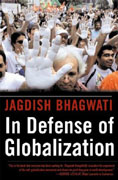In the fierce debate on globalization, Jagdish Bhagwati, a highly regarded authority on international trade who has advised the United Nations on globalization, stands out as a voice of reason. Currently teaching at Columbia University, he argues persuasively for the world-wide embrace of free trade in a book which should respond to some of the concerns that globalization has raised.
Reason and hope are keynotes of Bhagwati’s new book, titled In Defense of Globalization. The author has need of both, since trying to make sense of the contending voices in the debate requires the patience and detachment of a philosopher. Indeed, the debate on globalization resembles the classic philosophical scenario where four observers of a traffic accident, each on different corners of an intersection, are interviewed for their eye-witness accounts. Each, because of where he stands, has a different perspective of the event.
A look at the archives of the New York Times from October 2003 illustrates how this analogy applies to globalization. Three Times articles – Joseph Kahn’s examination of sweatshop working conditions in Anshan, China; Larry Rohter’s piece on the resistance of Bolivia’s poor to free trade, and Louis Uchitelle’s survey of the flight of U.S. jobs to other countries – provide apparently conclusive evidence that globalization is a head-on collision.
And what does Bhagwati see from his corner? He is far too humane a man to dismiss the cost to both industrialized and developing nations of job loss or poor working conditions. He does dispute many of the headline-grabbing assertions of the popular press, suggesting that political and societal factors frequently cause problems for which globalization is unfairly blamed. Taking the long view, he maintains that globalization is transforming the world’s economic and social structure for the better.
Bhagwati defines globalization as the “integration of national economies into the international economy through trade, direct foreign investment (by corporations and multinationals), short-term capital flows, international flows of workers and humanity generally, and flows of technology.”
He discusses globalization’s cultural and technological aspects, which critics contend are turning the planet into a homogenized “McWorld,” but focuses on the free trade and employment objectives of economic globalization and the politically charged arenas where all these contending forces come into play. In true scholastic style, he devotes chapters to specific issues, surveys the criticisms of the role that globalization plays and then responds with his own erudite refutation, or occasionally agreement.
Perhaps the most salient point of Bhagwati’s observations is that globalization must be understood in terms of “the rules of the game.” Corporations invest funds or build factories in countries in the hope of bettering their competitive advantage. But in doing so, these companies are often subject to manipulation by political leaders who have varying agendas. Some may welcome investment but discourage imports while others favor the free trade orientation which Bhagwati maintains is the best course. Each country has unique circumstances, and multinational corporations must adapt to them.
An “Active Pull-up Strategy”
Bhagwati argues convincingly that removal of trade barriers will promote greater levels of economic growth. This will trigger a rise in the income, consumption level and living standards of poor nations willing to take the risk of lowering tariffs, engaging in export driven commerce and cooperating with multinationals. For Bhagwati, economic globalization is an “active, pull-up strategy” rather than an example of the notorious “trickle down” theory from the 1980’s.
Why is Bhagwati’s vision of international trade not embraced by more economists and social theorists? For that matter, why did the 1999 World Trade Organization conference in Seattle spark violent protest among groups disenchanted by globalization?
Globalization has been assailed by a diversity of critics whose views range from broad stroke agendas to narrow, single issue concerns. Many of the critics, as Bhagwati notes, do not operate from an economic orientation, but base their opinions on social, even literary, theories. Deconstructionists, post-Modernists and Marxists assert that “values” rather than economics should provide the foundation for human society. More tightly focused critiques come from economists like Joseph Stiglitz on the correlation of unemployment rates with the freeing of trade, or the theory of Vito Tazi that the growth of e-commerce and the reliance of multinational corporations on offshore financial centers will seriously diminish the ability of nation states to raise needed revenue.
One of Bhagwati’s most revealing insights concerns the role that non-profit activist groups have played in the globalization debate. These non-governmental organizations (NGOs) number two million worldwide, with one million located in India. Only a small percent deal exclusively with the economic issues of globalization, although there is an impressive degree of media savvy in their operations, particularly the ability to make headlines with revelations of corporate misdeeds. Bhagwati, however, contends that the NGOs critical of globalization are often secretive in their own operations, deeply divided in their goals and prone to exaggerate figures of worker exploitation or environmental abuse.
“Halos should not be shields,” Bhagwati observes, refusing to concede the moral high ground to anyone who has not done his or her globalization homework. One NGO, however, handed in a most impressive study on globalization in July 2001. This was a report by the Center for Economic and Policy Research (CEPR) entitled, “The Scorecard on Globalization, 1980-2000: Twenty Years of Diminished Progress.” The conclusions of this study – prepared by CEPR co-directors Mark Weisbrot and Dean Baker and research associates Egor Kraev and Judy Chen – cast serious doubts on the ability of economic globalization to promote the kind of growth which Bhagwati sees as crucial to raising income and living standards throughout the world. Bhagwati does not address the “Scorecard on Globalization” in his book, a significant omission which deprives Defense of Globalization of the definitive status in economic literature which it might otherwise have attained.
The “Scorecard” concludes that “for economic growth and almost all of the other indicators, the last 20 years have shown a very clear decline in progress as compared with the previous two decades … Perhaps the most disturbing development was the fact that the poorest countries went from a modest rate of positive per capita GDP growth to declining per capita GDP in the second period.” In other words, the report states that developing nations actually experienced better economic results from 1960 to 1980 than in the last two decades of the twentieth century.
The “Scorecard” goes on to analyze how this slowdown adversely affected the world’s living standard. Progress in boosting life expectancy, reducing infant mortality and promoting educational growth all experienced disappointing reductions between 1980 and 2000, it says. The authors of the “Scorecard” state that the economic policies associated with globalization cannot be proven to be responsible for “the deterioration in performance.” But “a very strong prima facie case [can be made] that some structural and policy changes implemented during the last two decades are at least partly responsible for these declines.”
It is unfortunate that Bhagwati did not comment at length on this report. On the surface, the “Scorecard” would appear to contradict his belief that lowering tariff barriers, emphasizing exports and cooperating with multinationals will propel both rich and poor nations in a forward “race to the top.” Yet an analysis of the “Scorecard” actually reinforces some of Bhagwati’s conclusions. For instance, it notes that the 1997 Asian financial crisis was caused by financial markets which pumped in massive amounts of capital and then rapidly withdrew it. Bhagwati agrees with this assessment, noting that the economies of the countries involved in the crisis – Thailand, South Korea, Indonesia, Malaysia and the Philippines – were fundamentally sound. All had embraced free trade. The crisis was largely one of poor management, “a product of hasty and imprudent financial liberalization, almost always under foreign pressure, allowing free international flows of short-term capital without adequate attention to the potentially potent downside of globalization.”
Distrust of World Bank
Bhagwati’s censure of “gung-ho international financial capitalism” shows that he is no doctrinaire defender of unregulated financial markets. He praises the imposition of capital controls by Malaysia in 1998, even though this earned the disapproval of the International Monetary Fund. It’s an important point because the lack of safeguards in open financial markets, along with arbitrary policy decisions of the IMF and the World Bank – especially concerning the privatization of public utilities – are among the most significant factors giving globalization a black eye.
For Bhagwati, the principles of economic globalization are a means to help poor nations escape poverty and help developed nations continue flourishing. He contends there is a lack of evidence that multinationals encourage violations of workers’ rights by poor countries seeking to attract these companies. He likewise maintains that globalization has not adversely affected wages and working conditions in the United States.
In almost every case, Bhagwati’s analysis of the issues involved in globalization are well reasoned and worthy of consideration. Yet, it is hard to suppress the feeling that he missed an opportunity to write a definitive text on his subject. When it comes to recommending policy decisions on how to govern a globalized economy, his grasp weakens. His proposal that the “World Bank … should put its money where its pro-globalization mouth is” to help poor nations is a case in point. Given the distrust of the World Bank and the IMF among developing nations, a “should” like this is not going to instill much confidence. Nor is Bhagwati’s advice likely to have much effect so long as the United States wages war against terrorism primarily through military rather than economic means.
Despite these caveats, In Defense of Globalization is an impressive book. It represents a major step toward defining a more equitable economic model for a world which sadly seems intent on taking giant strides backward away from the ideals of a global community. We can only hope that Jagdish Bhagwati will not become a prophet scorned.



